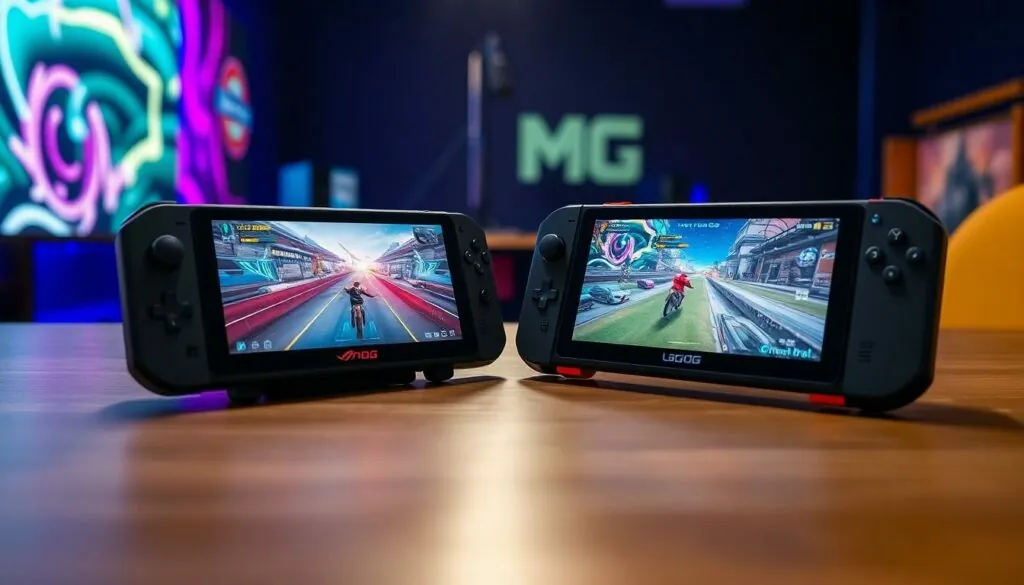In the ever-evolving world of portable gaming, two titans have emerged: the ROG Ally and the Lenovo Legion Go. These handheld devices promise to deliver gaming on the go, but the real question is, which one reigns supreme? Picture this: one device offers jaw-dropping graphics and speed, while the other boasts an ergonomic design that feels like it was crafted by a team of gaming gods.
As gamers weigh their options, the stakes are high. Choosing the right handheld can make the difference between epic victories and frustrating defeats. So grab your snacks and settle in, because this showdown is about to get intense. Let’s dive into the specs, features, and quirks of these two gaming powerhouses to see which one deserves a spot in your backpack.
Table of Contents
ToggleOverview of ROG Ally and Lenovo Legion Go
ROG Ally offers powerful performance, equipped with an AMD Ryzen Z1 Extreme processor. This hardware provides high frame rates and smooth gameplay, essential for gamers seeking thrilling experiences. On the other hand, Lenovo Legion Go features an AMD Ryzen Z1 processor or an equivalent option, which balances performance and battery life effectively.
Display quality remains a critical factor for portable gaming devices. ROG Ally showcases a 7-inch Full HD display with a 120Hz refresh rate, enhancing the gaming experience with vibrant colors and fluid motion. In comparison, Lenovo Legion Go also sports a 7-inch display, but it delivers a 144Hz refresh rate, promising an even smoother visual experience.
Another aspect worth noting is the design and ergonomics of both devices. ROG Ally focuses on a sleek design, making it lightweight and easy to carry. Lenovo Legion Go emphasizes comfort, featuring a unique grip that supports extended gaming sessions without strain.
Both devices offer storage options catering to different needs. ROG Ally provides up to 512GB SSD storage, with expandable options through microSD cards. Conversely, Lenovo Legion Go includes an up to 1TB SSD storage capacity, which accommodates larger game libraries.
Connectivity features differ as well. ROG Ally supports Bluetooth and Wi-Fi 6, ensuring stable connections for online gaming. Lenovo Legion Go also includes Bluetooth and Wi-Fi connectivity, providing users more flexibility in multiplayer gaming environments.
While both ROG Ally and Lenovo Legion Go present attractive features and capabilities, their performance, display quality, ergonomics, and storage options cater to different gaming preferences.
Design and Build Quality
The design and build quality of the ROG Ally and Lenovo Legion Go significantly impact their usability and overall appeal for gamers.
ROG Ally Design Features
ROG Ally showcases a sleek, lightweight profile, enhancing portability without sacrificing durability. The 7-inch Full HD display, combined with a 120Hz refresh rate, ensures vibrant visuals and smooth gameplay. Button placement and layout prioritize accessibility, allowing for effortless navigation during intense gaming sessions. Additionally, the ergonomic contours contribute to comfort, making extended play more enjoyable. Premium materials used in construction enhance both aesthetics and resilience, creating an appealing overall package for gamers seeking mobility.
Lenovo Legion Go Design Features
Lenovo Legion Go features a robust build designed for extended gaming sessions, focusing on comfort and usability. Its 7-inch display, with a 144Hz refresh rate, elevates visual performance, providing smoother action during gameplay. Unique grip design allows for a secure hold, minimizing fatigue even after hours of use. The distinct button arrangement promotes intuitive access to controls, enhancing user experience. High-quality materials not only improve durability but also give the device a modern, gaming-focused aesthetic.
Performance Comparison
The ROG Ally and Lenovo Legion Go offer distinct advantages, making their performance a crucial aspect for gamers to consider.
Processor and Graphics
ROG Ally features an AMD Ryzen Z1 Extreme processor, delivering outstanding graphics and speed. This powerful combination allows for high-quality gaming experiences with stunning visuals. In contrast, Lenovo Legion Go incorporates an AMD Ryzen Z1 processor, which strikes a balance between performance and overall efficiency. Although slightly less powerful, it still provides competent graphics for most modern titles. Both devices support various gaming genres, enabling seamless gameplay. Gamers looking for intensive titles may prefer the ROG Ally due to its enhanced processing power, while those seeking balanced performance might opt for the Legion Go.
Battery Life
Battery life significantly impacts portable gaming experiences. ROG Ally offers a competitive battery life that supports extended gaming sessions, although battery longevity can vary depending on usage. Lenovo Legion Go, however, excels with its impressive battery performance, often providing longer gaming durations on a single charge. Users engaged in prolonged gaming sessions benefit from the Legion Go’s optimized energy consumption. Choosing the right device in terms of battery life ultimately depends on individual gaming habits and preferences, with each offering strengths to accommodate different styles.
Display and Sound Quality
Display and sound quality play vital roles in determining the gaming experience on portable devices. Here’s how the ROG Ally and Lenovo Legion Go measure up.
ROG Ally Display Specifications
The ROG Ally features a 7-inch Full HD display that delivers clarity and vivid colors. It boasts a 120Hz refresh rate, ensuring smooth motion during gameplay. Viewing angles remain impressive, allowing for an immersive experience in various lighting conditions. Its adaptive brightness enhances visibility, whether indoors or outdoors. Additionally, the display supports AMD FreeSync technology, reducing screen tearing during action-packed games. Overall, the visuals stand out, making the ROG Ally suitable for gamers seeking high-quality graphics.
Lenovo Legion Go Display Specifications
A 7-inch display on the Lenovo Legion Go offers an exceptional visual experience with a 144Hz refresh rate. This higher refresh rate enables even smoother animations and responsiveness during games. Color accuracy remains high, making it ideal for gamers who prioritize detail. The display also incorporates anti-glare technology, facilitating comfortable gameplay under different lighting environments. Furthermore, HDR support enhances contrast and brightness levels, adding depth to visuals. These specifications position the Lenovo Legion Go as a strong contender for gamers who value display excellence.
User Experience and Software
User experience plays a critical role in the overall appeal of both the ROG Ally and Lenovo Legion Go. Examining software interfaces and usability reveals key differences that cater to diverse gaming preferences.
Interface and Usability
The ROG Ally employs a streamlined user interface, making navigation intuitive for gamers. Users appreciate the straightforward layout, which prioritizes quick access to games and settings. On the other hand, Lenovo Legion Go incorporates a customizable interface designed for personalized gaming experiences. Gamers can rearrange elements according to their preferences, enhancing usability. Both devices provide responsive touchscreens, yet ROG Ally’s interface offers a more unified feel, contributing to seamless transitions during gameplay.
Game Library Compatibility
Compatibility with game libraries can significantly influence purchasing decisions. ROG Ally excels with support for a wide range of gaming platforms, including Steam and Xbox Game Pass, providing access to an extensive library of titles. Lenovo Legion Go also supports multiple platforms, catering to gamers seeking varied options. Both devices run Windows, ensuring compatibility with numerous PC games. However, ROG Ally’s emphasis on broader accessibility leads some users to prefer it for their gaming needs.
Price and Value for Money
Comparing prices reveals significant differences between the ROG Ally and Lenovo Legion Go. ROG Ally generally starts around $600, while Lenovo Legion Go’s price frequently ranges from $700 to $800 for the base model. Each device offers its own value, influenced by performance and features.
ROG Ally provides robust performance for players who enjoy intensive gaming. Its price point reflects the advanced AMD Ryzen Z1 Extreme processor, which drives superior graphics and speed. Lenovo Legion Go’s emphasis on battery life and storage capacity justifies its higher price. Many gamers find the 1TB storage appealing for maintaining larger game libraries.
An analysis of specifications also indicates differing value propositions. ROG Ally’s 512GB SSD storage, though less than Lenovo’s, can be expanded with microSD options. Some users prioritize this expansion capability for their gaming needs, noting the potential for cost-effectiveness over time.
Durability plays a role in perceived value, where ROG Ally’s lightweight and sleek design appeals to those seeking portability. Conversely, Lenovo Legion Go’s more robust design caters to players who prefer extended gaming sessions without compromising comfort.
When considering potential resale value, ROG Ally receives praise for its brand reputation and popularity within the gaming community. Lenovo Legion Go, however, might retain value due to its continuous updates and robust support, catering to long-term users.
Both devices present unique pricing structures and value, appealing to different aspects of the gaming experience. Personal preferences and gaming styles heavily influence the ultimate decision on which device offers better value for money.
Conclusion
Choosing between the ROG Ally and Lenovo Legion Go ultimately hinges on individual gaming preferences and needs. The ROG Ally excels in graphics and speed, making it a strong contender for gamers seeking high-performance visuals. Its lightweight design and expandable storage options further enhance its appeal.
On the other hand, the Lenovo Legion Go stands out with its impressive battery life and comfortable grip for extended sessions. Its superior display quality and larger storage capacity cater to those who prioritize visual excellence and ample game libraries.
Both devices offer unique strengths that cater to different gaming styles. Understanding these differences can help gamers make an informed decision tailored to their specific requirements.









